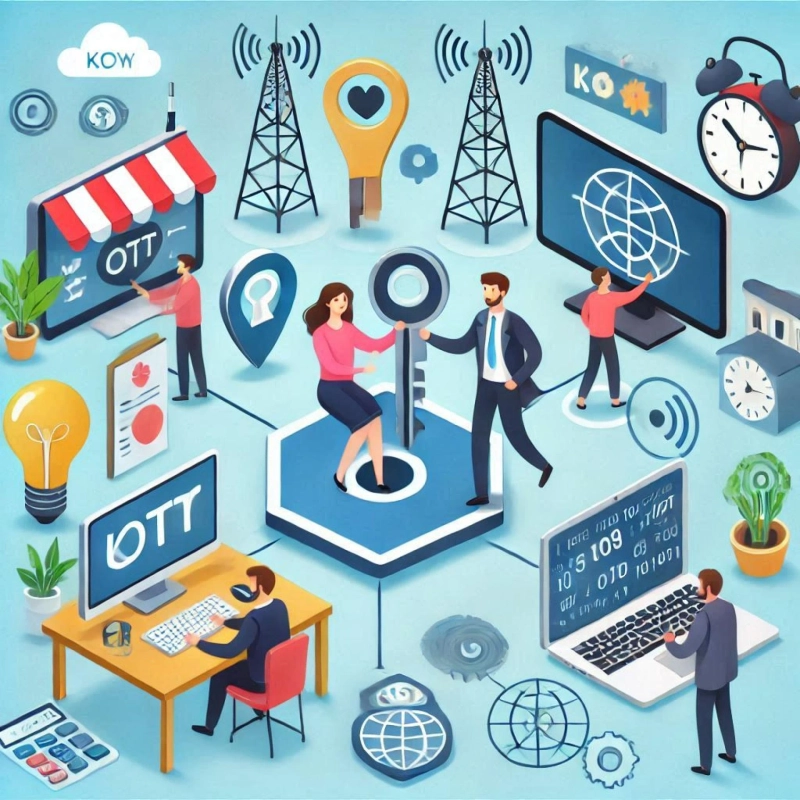The growth of over-the-top (OTT) streaming platforms has redefined the way we consume entertainment. From binge-watching our favorite shows to streaming live sports events, OTT streaming platforms have become a household name. But as the OTT ecosystem grows, one common area of confusion is the distinction between OTT service providers and OTT platforms. Understanding these differences is essential for businesses, content creators, and consumers alike.
What Is an OTT Streaming Platform?
An OTT streaming platform refers to the technology and digital infrastructure that enables the delivery of video, audio, and other multimedia content directly to users over the internet. Unlike traditional cable or satellite systems, OTT platforms bypass traditional distribution methods, giving users access to content on-demand and across multiple devices. Examples of popular OTT streaming platforms include Netflix, Hulu, Amazon Prime Video, and Disney+.
OTT Service Providers vs. OTT Streaming Platforms
At first glance, “OTT service providers” and “OTT streaming platforms” may appear interchangeable. However, they play distinct roles in the OTT ecosystem. Here’s a closer look at each:
OTT Service Providers
OTT service providers are companies or entities that create and manage the content distributed through OTT platforms. These providers focus on content production, licensing, and aggregation. For instance:
- Content Creators: These are studios or individuals producing original movies, TV shows, documentaries, or live broadcasts.
- Aggregators: Companies that acquire licenses for various content types and package them for streaming.
- Broadcasters: Traditional networks like CBS and BBC, which extend their offerings to OTT platforms via apps like CBS All Access or BBC iPlayer.
OTT Streaming Platforms
On the other hand, an OTT streaming platform provides the technical infrastructure to host, deliver, and monetize content. They enable service providers to distribute their media seamlessly to users across devices. These platforms often include features such as adaptive streaming, user analytics, content recommendation engines, and secure payment gateways.
Key Components of an OTT Streaming Platform
A robust OTT streaming platform comprises several critical components, each serving a unique purpose to deliver high-quality content:
- Content Management System (CMS): This is where media assets are stored, organized, and managed.
- Content Delivery Network (CDN): A network of servers ensures smooth and fast delivery of content worldwide.
- Video Encoding and Transcoding: Optimizes video files for seamless playback across various devices and internet speeds.
- User Interface (UI) and User Experience (UX): An intuitive, visually appealing interface ensures users can easily navigate and find content.
- Monetization Models: Platforms often offer various revenue options such as subscription-based (SVOD), ad-supported (AVOD), or transactional (TVOD).
- Security Features: Encryption, digital rights management (DRM), and multi-factor authentication protect content from piracy and unauthorized access.
- Analytics Tools: Provide insights into viewer behavior, helping service providers refine their strategies.
The Business Perspective: Choosing Between Building a Platform and Partnering with Providers
For businesses entering the OTT space, the decision to create their own OTT streaming platform or partner with existing providers is pivotal. Here are the pros and cons of each approach:
Building Your Own OTT Streaming Platform
Advantages:
- Full control over branding, user experience, and monetization strategies.
- Greater flexibility to customize features and integrate third-party tools.
- Direct access to user data, enabling tailored marketing and content recommendations.
Challenges:
- High upfront investment in technology, development, and infrastructure.
- Requires continuous updates to stay competitive.
- Demands expertise in streaming technology, user experience design, and digital marketing.
Partnering with OTT Service Providers
Advantages:
- Faster time-to-market with ready-made solutions.
- Access to an existing audience base.
- Lower operational costs compared to building a platform from scratch.
Challenges:
- Limited control over branding and user experience.
- Revenue sharing with the platform owner.
- Dependency on the platform’s technology and policies.
The Evolution of OTT Streaming Platforms: Trends to Watch
The OTT streaming industry is evolving rapidly, driven by technological advancements and changing viewer preferences. Here are some trends shaping the future of OTT platforms:
1. AI and Machine Learning
OTT platforms are leveraging AI to enhance content recommendations, automate metadata tagging, and optimize video quality. Machine learning algorithms analyze user behavior to provide personalized experiences that boost engagement.
2. Live Streaming and Interactive Content
Live sports, concerts, and interactive content are becoming integral to OTT platforms. Technologies like ultra-low latency streaming ensure real-time interactions, making the experience more engaging.
3. Hybrid Monetization Models
While subscription-based models dominate, many platforms are exploring hybrid approaches, combining SVOD, AVOD, and TVOD to maximize revenue.
4. Immersive Technologies
Virtual reality (VR) and augmented reality (AR) are gaining traction in the OTT space. Platforms are experimenting with 360-degree videos and immersive experiences to captivate audiences.
5. Regional Content and Localization
OTT platforms are increasingly investing in regional content to cater to diverse audiences. Localization efforts, including subtitles and dubbing, play a crucial role in expanding global reach.
Real-World Examples of OTT Service Providers and Platforms
To illustrate the difference, let’s examine some real-world scenarios:
- Netflix: Operates as both a service provider (producing original content like Stranger Things) and a platform.
- YouTube: Functions as an OTT streaming platform, allowing independent creators to act as service providers.
- HBO Max: Combines original content from HBO (service provider) with WarnerMedia’s extensive library, delivered through its proprietary platform.
- Roku: Primarily an OTT streaming platform offering a marketplace for various service providers to reach users.
Statistics and Market Insights
- The global OTT streaming platform market was valued at $121.61 billion in 2023 and is projected to grow at a CAGR of 14.3% from 2023 to 2030.
- As of 2024, over 82% of internet users globally have accessed an OTT platform.
- Mobile devices account for nearly 60% of OTT consumption, highlighting the importance of mobile-optimized platforms.
- Netflix remains the market leader, with over 238 million subscribers worldwide as of Q4 2024.
Final Thoughts
OTT streaming platforms and service providers are two sides of the same coin, working together to deliver content that meets the evolving demands of viewers. Whether you’re a business aiming to enter the OTT space or a consumer seeking the best streaming experience, understanding their roles can help you make informed decisions. As technology continues to advance and the competition heats up, the OTT landscape promises even more innovation and growth. Embrace the future of entertainment with a clear understanding of the differences and opportunities in the OTT ecosystem.


